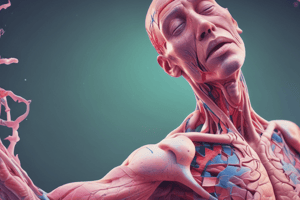Podcast
Questions and Answers
What is the main cause of Marfan syndrome?
What is the main cause of Marfan syndrome?
- Weakened muscles and organs
- Developmental problems in connective tissue
- Overgrowth of bones
- Changes in the amount of fibrillin-1 and cell function due to a gene mutation (correct)
Which part of the body can Marfan syndrome affect?
Which part of the body can Marfan syndrome affect?
- Respiratory system and endocrine system
- Digestive system, kidneys, and nervous system
- Eyes, heart, blood vessels, skin, and lungs (correct)
- Skeletal system and reproductive system
What role does fibrillin-1 protein play in the body?
What role does fibrillin-1 protein play in the body?
- Regulates hormone production
- Controls bone density and strength
- Helps make elastic fibers in connective tissue and affects the function of transforming growth factor-beta (TGF-beta) (correct)
- Supports muscle and tissue development
What is the primary impact of Marfan syndrome on tissues throughout the body?
What is the primary impact of Marfan syndrome on tissues throughout the body?
What is the specific effect of the gene mutation associated with Marfan syndrome?
What is the specific effect of the gene mutation associated with Marfan syndrome?
What is the cause of Marfan syndrome?
What is the cause of Marfan syndrome?
Which symptom is common in individuals with Marfan syndrome?
Which symptom is common in individuals with Marfan syndrome?
What is a common cardiovascular problem associated with Marfan syndrome?
What is a common cardiovascular problem associated with Marfan syndrome?
Which complication is commonly associated with Marfan syndrome?
Which complication is commonly associated with Marfan syndrome?
What type of pain is commonly experienced by individuals with Marfan syndrome?
What type of pain is commonly experienced by individuals with Marfan syndrome?
Flashcards
Marfan Syndrome
Marfan Syndrome
A genetic disorder affecting connective tissue, caused by a mutation in the FBN1 gene, leading to changes in fibrillin-1 production and TGF-beta function.
Fibrillin-1
Fibrillin-1
A protein involved in the formation of elastic fibers in connective tissue, crucial for maintaining tissue integrity and regulating TGF-beta signaling.
TGF-beta
TGF-beta
A growth factor that plays a role in regulating cell growth and differentiation, impacting various bodily functions, including tissue development and wound healing.
Aortic Aneurysm
Aortic Aneurysm
Signup and view all the flashcards
Lens Dislocation
Lens Dislocation
Signup and view all the flashcards
Arachnodactyly
Arachnodactyly
Signup and view all the flashcards
Lower Back Pain and Numbness
Lower Back Pain and Numbness
Signup and view all the flashcards
Cardiovascular Complications
Cardiovascular Complications
Signup and view all the flashcards
Lung Cysts
Lung Cysts
Signup and view all the flashcards
Autosomal Dominant Inheritance
Autosomal Dominant Inheritance
Signup and view all the flashcards
Study Notes
Marfan Syndrome Overview
- Marfan syndrome is primarily caused by a mutation in the gene that codes for fibrillin-1 protein.
Effects on the Body
- Marfan syndrome can affect various parts of the body, including the heart, blood vessels, eyes, skeleton, and nervous system.
Fibrillin-1 Protein Role
- Fibrillin-1 protein plays a crucial role in the formation of elastic fibers that provide strength and elasticity to connective tissue.
Impact on Tissues
- The primary impact of Marfan syndrome on tissues throughout the body is the weakening of connective tissue, leading to various complications.
Gene Mutation Effect
- The specific effect of the gene mutation associated with Marfan syndrome is the production of abnormal or reduced amounts of fibrillin-1 protein.
Symptoms and Complications
- Tall, slender build is a common symptom in individuals with Marfan syndrome.
- A common cardiovascular problem associated with Marfan syndrome is aortic aneurysm or aortic dissection.
- Eye problems, such as dislocated lenses, are a common complication associated with Marfan syndrome.
- Individuals with Marfan syndrome often experience musculoskeletal pain, particularly back pain, due to spinal abnormalities.
Studying That Suits You
Use AI to generate personalized quizzes and flashcards to suit your learning preferences.




